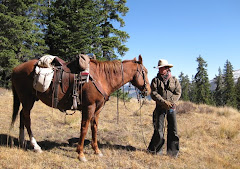
 There are a lot of adjustments to the pack saddle rigging. Spend the time to properly fix and place each strap for the most comfortable fit for your horse. The only tight fit should be with both cinches. The breast collar and crupper should be comfortable – not tight, but not so loose it hangs and rubs. Keep a good eye on your stock, especially the first few trips. Our goal is always to have our stock arrive home after a trip without rubbing, scarring or chaffing.
There are a lot of adjustments to the pack saddle rigging. Spend the time to properly fix and place each strap for the most comfortable fit for your horse. The only tight fit should be with both cinches. The breast collar and crupper should be comfortable – not tight, but not so loose it hangs and rubs. Keep a good eye on your stock, especially the first few trips. Our goal is always to have our stock arrive home after a trip without rubbing, scarring or chaffing.Like I mentioned in an earlier Floyd Story, you can over tighten the load and have a very uncomfortable horse. As with a good rider that can safely ride with a loose cinch by adjusting his or her body weight, what’s more important that a super-tight cinch is the equally balanced loads.
So, that’s where we’ll begin. Before packing the load, you need to sort and weigh the load. I can’t stress the importance of this step enough. Your goal is for equal weight and bulk on each side of the horse. Really equal. “Sort of” is not good enough. We use soft sided canvas or iron cloth panniers, and choose the gear to fit in each so that each pannier ends up approximately the same size, and definitely the same weight. Each pannier is weighed on a hanging scale (hanging from a rope in our barn or packing area at home, or from a tree limb or strong human packer at camp), and adjusted accordingly. Our goal is to be exactly equal. We will settle for no more than a pound difference. This may sound crazy, but we’ll throw in a rock to balance the load. I believe it is that important. Otherwise, you’re relying on the tightness of the lash ropes and cinches, and I don’t think my horse needs anything strapped on that tightly.
As for maximum weight, a common question asked by our clients each year, it all depends on your stock, your trails, and how far you’ll be going. We don’t overload our stock. We start at 10,000 feet elevation and go up from there on some very challenging, steep and rocky high mountain trails. I don’t need to kill my horse, or even have him wiped out or injured, for anyone’s load. We average our max load at 125 or 150 total weight per horse. That means that 125 or 150 pounds has to be evenly divided between the two panniers and the top load. (I do not include the saddle and rigging in this figure.) That ends up being plenty of weight and bulk, dead weight, mind you, for our stock to climb up these mountain trails.
To pack the load on the horse, we work as team, one of us holding the horse and reaching over to adjust the straps, as the other one lifts the panniers up onto the pack saddle rigging. When the panniers and top load are in place, a mantee or folded tarp is laid over the load. The load is then secured with the lash rope and cinch.
I imagine every packer has his or her own favorite way to secure the load. We stick with the box hitch. It’s worked for my husband quite well for 30 or 40 years now. You can learn and master “fancier” hitches like the Diamond. Whatever works for you. It is personal preference, and I imagine the several options will all work well if they are done right.
Double check your work. Loads must be even, and you can tell just from looking at your final packed stock if it is all hanging tight, secure and evenly. If not, believe me, it’s a lot easier to stop and re-pack at home or at the trail head, than on the trail after your full pack saddle rolled under the belly of your horse or mule.





